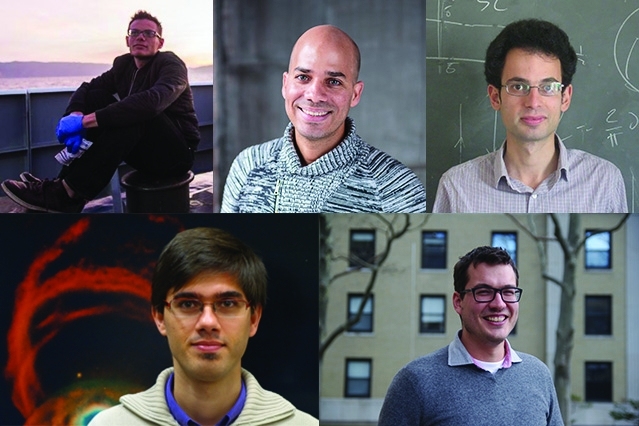The School of Science welcomes five new professors in the departments of Biology; Earth, Atmospheric and Planetary Sciences (EAPS); and Physics. Their research ranges from RNA metabolism, to earth processes such as the nitrogen cycle and plate tectonic movements, and to the physics of quantum condensed matter and gravitational waves.
Andrew Babbin is a marine biogeochemist working on the nitrogen cycle, especially on the processes that return fixed nitrogen in the ocean back to nitrogen gas. This work is relevant, for instance, for understanding the controls on marine productivity and the ocean’s potential for storing carbon. Babbin has already made major contributions to this field, especially with regard to the contributions of anaerobic metabolisms in the ocean. He aims to expand his observational biogeochemical studies by using microfluidic devices to reproduce a variety of chemical conditions simultaneously and finely control the chemistry experienced by microbes.
After earning a BS summa cum laude in earth and environmental engineering from Columbia University in 2008, Babbin completed his PhD in 2014 under the direction of Professor Bess Ward in the Princeton University Department of Geosciences. After a National Science Foundation Postdoctoral Fellowship in the MIT Department of Civil and Environmental Engineering studying microbial community development in the environment, Babbin began his appointment as an assistant professor in EAPS in January.
Eliezer Calo focuses on the coordination of RNA metabolism using a combination of genetic, biochemical, and functional genomic approaches. The core of Calo’s research program is to understand how ribosome biogenesis is controlled by specific RNA binding proteins, particularly RNA helicases of the “DEAD box” family, and how disregulation of ribosome biogenesis contributes to various diseases, including cancer. He proposes initially to characterize the functions of specific genes of interest, including the DDX21 RNA helicase and the TCOF1 factor involved in RNA Pol I transcription and rRNA processing, using biochemical, molecular, and genome-wide approaches in mouse, Xenopus and Zebrafish models.
Calo is a familiar figure at MIT, having participated in MIT’s Summer Research Program. After the 2006 completion of his undergraduate degree in chemistry from the University of Puerto Rico, he returned to MIT to pursue his PhD in cancer biology under the direction of Jacqueline Lees. In 2011, Calo began postdoctoral work at the Stanford University School of Medicine with Joanna Wysocka, where he changed fields from cancer biology to RNA biology. He returned to the MIT Department of Biology in January as an assistant professor.
Max Metlitski works in the field of quantum condensed matter theory. The goal of his research is to understand different electronic phases of solids, which can exist at low temperature when quantum effects are important, as well as transitions between these phases. He is particularly interested in systems where interactions between electrons play a key role. His most recent work focuses on states of matter that have a topological twist to them, and reveals deep and previously unsuspected connections between four distinct topics: the two-dimensional electron gas in a strong magnetic field; three-dimensional topological insulators; three-dimensional quantum spin liquids; and exotic phase transitions in two-dimensional magnetic insulators.
Metlitski received a BS in physics and mathematics (2003) and an MS in physics (2005) from the University of British Columbia in Canada. After earning his PhD in physics from Harvard University in 2011, he held a postdoctoral position at the Kavli Institute for Theoretical Physics at the University of California at Santa Barbara until 2015. Metlitski joined the MIT Department of Physics as an assistant professor in January, after a faculty appointment at the Perimeter Institute for Theoretical Physics.
Matěj Peč studies the mechanical and microstructural response of rocks to various driving forces associated with plate tectonic movements. To this end, he performs high-pressure, high-temperature experiments in the laboratory and compares the results to natural observations and theoretical models. His work so far has focused on elucidating the processes occurring at the base of the seismogenic layer where brittle and viscous deformation mechanisms act together to accommodate strain. Further, he studies melt migration in partially molten rocks and the processes that lead to magma emplacement along mid-ocean ridges. He is particularly interested in the influence of melt-rock reactions and stress on melt migration in the upper mantle.
Peč has a BS in geology and an MS in structural geology from the Charles University in Prague in the Czech Republic. During his master's studies, he spent a year at the University of Montpellier II in France as an ERASMUS scholar. He then pursued a PhD in rock mechanics under the supervision of Renée Heilbronner and Holger Stünitz at the University of Basel in Switzerland, from where he graduated in 2012. After his PhD, he joined the laboratory of David L. Kohlstedt at the University of Minnesota as a postdoc. He joined EAPS as an assistant professor in January.
Salvatore Vitale focuses on data analysis for gravitational waves signals detected with the LIGO instruments, including tests of general relativity using gravitational waves and assessing the typical accuracy used to estimate the physical parameters of the source collisions being detected, with special interest on sky localization of the collisions. Vitale will help lead the MIT LIGO data analysis effort, which is expected to grow more prominent as the LIGO instruments’ sensitivity improves and increasing numbers of discoveries are likely to be made. Vitale received his bachelor’s degree in physics (2005) and master’s degree in theoretical physics (2007) from the University of Bologna in Italy. He received his PhD in 2010 from the University Pierre and Marie Curie-Paris VI, and then held a postdoctoral position for two years at the Nikhef of Amsterdam in the Netherlands. Vitale joined MIT in 2012 as a postdoc and then research scientist. He began his appointment as assistant professor in the Department of Physics in January.






